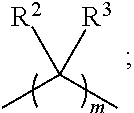Lubricant additive compositions containing thiophosphates and thiophosphate derivatives
a technology of thiophosphate and additive composition, which is applied in the field of thiophosphates, can solve the problems of reducing oxidative stability, poor sealing durability, and performance attributes, and achieves the effect of prolonging the functional life of an elastomeric seal
- Summary
- Abstract
- Description
- Claims
- Application Information
AI Technical Summary
Benefits of technology
Problems solved by technology
Method used
Image
Examples
example 1
[0217]
[0218]Intermediate P1-A (600 g, 1.68 moles) was combined with O,O-di-isopropyl dithiophosphoric acid (180 g, 0.84 moles; used as supplied by Cheminova) in a round bottomed flask equipped with a magnetic stirring bar. The reaction contents were heated to 90° C. under reduced pressure (10 mm Hg). Throughout the reaction isopropanol was distilled off and collected into a separate cooled vessel. After 6.5 hours the reaction contents were cooled to 10° C. and propylene oxide (49 g, 0.84 moles; Sigma Aldrich) slowly added to the stirring reaction over a 45 minute period. At this time O,O-di-isopropyl dithiophosphoric acid (376 g, 1.76 moles; used as supplied by Cheminova) was added and the reaction mixture heated at 90° C. and 10 mm Hg of pressure for 6 hours before cooling to room temperature. Ethyl acrylate (270 g, 2.7 moles; Dow Chemical) was next added to the reaction and the temperature brought to 70° C. for 2 hours. Subsequently, the reaction was brought to 80° C. and a 100 mm...
example 2
[0219]
[0220]Intermediate P3-A (345 g, 0.4 moles) was combined with O,O-di-isopropyl dithiophosphoric acid (43 g, 0.2 moles; used as supplied by Cheminova) and the reaction mixture heated at 90° C. and 10 mm Hg of pressure for 6 hours before cooling to room temperature. Ethyl acrylate (20 g, 0.2 moles; Dow Chemical) was next added to the reaction and the temperature brought to 70° C. for 2 hours. Subsequently, the reaction was brought to 80° C. and a 100 mm Hg vacuum applied until ethyl acrylate no longer distilled off into the cold trap. The presence of Example 2 was confirmed by 31P NMR.
example 3
[0221]
[0222]Intermediate P4-A (200 g, 0.2 moles) was combined with acrylic acid (14 g, 0.19 moles) and the reaction left to stir at 70° C. for two hours before applying a 10 mm Hg vacuum to strip off any remaining volatiles. The presence of Example 3 was confirmed by 31P NMR.
PUM
| Property | Measurement | Unit |
|---|---|---|
| viscosity index | aaaaa | aaaaa |
| temperature | aaaaa | aaaaa |
| temperature | aaaaa | aaaaa |
Abstract
Description
Claims
Application Information
 Login to View More
Login to View More - R&D
- Intellectual Property
- Life Sciences
- Materials
- Tech Scout
- Unparalleled Data Quality
- Higher Quality Content
- 60% Fewer Hallucinations
Browse by: Latest US Patents, China's latest patents, Technical Efficacy Thesaurus, Application Domain, Technology Topic, Popular Technical Reports.
© 2025 PatSnap. All rights reserved.Legal|Privacy policy|Modern Slavery Act Transparency Statement|Sitemap|About US| Contact US: help@patsnap.com



